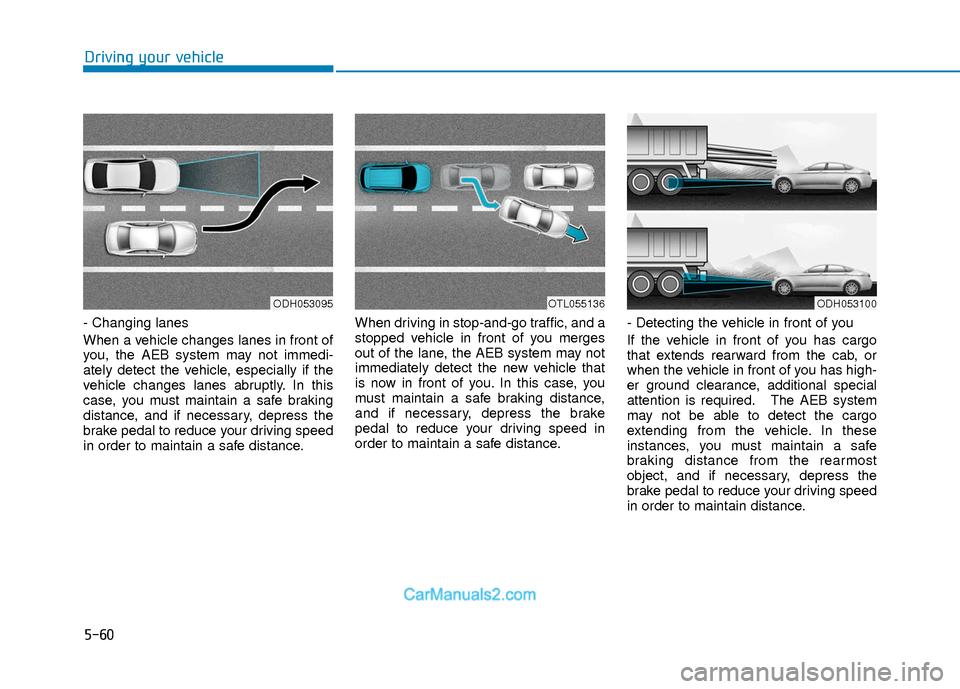Page 74 of 526
2-57
Safety system of your vehicle
2
In an angled collision, the force of impact
may direct the occupants in a direction
where the air bags would not be able to
provide any additional benefit, and thus
the sensors may not deploy any air bags.Just before impact, drivers often brake
heavily. Such heavy braking lowers the
front portion of the vehicle causing it to
"ride" under a vehicle with a higher
ground clearance. Air bags may not
inflate in this "under-ride" situation
because deceleration forces that are
detected by sensors may be significantly
reduced by such "underride" collisions.Front air bags may not inflate in rollover
accidents because air bag deployment
could not provide protection to the occu-
pants.
However, side and curtain air bags may
inflate when the vehicle is rolled over by
a side impact collision.
ODH033076OLF034057OAD035050
Page 343 of 526

5-60
Driving your vehicle
- Changing lanes
When a vehicle changes lanes in front of
you, the AEB system may not immedi-
ately detect the vehicle, especially if the
vehicle changes lanes abruptly. In this
case, you must maintain a safe braking
distance, and if necessary, depress the
brake pedal to reduce your driving speed
in order to maintain a safe distance.When driving in stop-and-go traffic, and a
stopped vehicle in front of you merges
out of the lane, the AEB system may not
immediately detect the new vehicle that
is now in front of you. In this case, you
must maintain a safe braking distance,
and if necessary, depress the brake
pedal to reduce your driving speed in
order to maintain a safe distance.
- Detecting the vehicle in front of you
If the vehicle in front of you has cargo
that extends rearward from the cab, or
when the vehicle in front of you has high-
er ground clearance, additional special
attention is required. The AEB system
may not be able to detect the cargo
extending from the vehicle. In these
instances, you must maintain a safe
braking distance from the rearmost
object, and if necessary, depress the
brake pedal to reduce your driving speed
in order to maintain distance.
ODH053095OTL055136ODH053100
Page 399 of 526

6-18
What to do in an emergency
When driving with the compact spare
tire mounted to your vehicle:
Check the tire pressure after installing the compact spare tire.
The compact spare tire should be
inflated to 60 psi (420 kPa).
Do not take this vehicle through an automatic car wash while the com-
pact spare tire is installed.
Do not use the compact spare tire on any other vehicle because this
tire has been designed especially
for your vehicle.
The compact spare tire’s tread life is shorter than a regular tire.
Inspect your compact spare tire
regularly and replace worn com-
pact spare tires with the same size
and design, mounted on the same
wheel.
Do not use more than one compact spare tire at a time. When the original tire and wheel
are repaired and reinstalled on the
vehicle, the lug nut torque must be
set correctly. The correct lug nut
tightening torque is 79~94 lbf·ft
(11~13 kgf·m).
NOTICE
To prevent damaging the com-
pact spare tire and your vehicle:
Drive slowly enough for the
road conditions to avoid all
hazards, such as a potholes
or debris.
Avoid driving over obstacles.
The compact spare tire diame-
ter is smaller than the diame-
ter of a conventional tire and
reduces the ground clearance
approximately 1 inch (25 mm).
Do not use tire chains on the
compact spare tire. Because
of the smaller size, a tire chain
will not fit properly.
Do not use the compact spare
tire on any other wheels, nor
should standard tires, snow
tires, wheel covers or trim
rings be used with the com-
pact spare wheel.
CAUTION